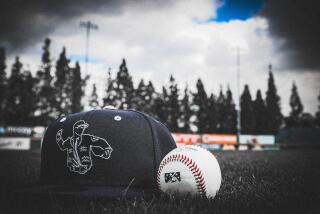Code Names Hold the Key for Computer Software Writers
- Share via
MOUNTAIN VIEW, Calif. — “Battlestar” primed Oracle Corp. software writers for combat, while “Cheddar” whetted appetites for success at Netscape Communications Corp.
Forget the painstaking design, months of testing, marketing plans. When it comes to successful software, it’s the code name that counts.
At least that’s what programmers say. They claim they couldn’t flex a mental muscle, let alone write programming code around the clock, without a theme to bind them to their project. Windows 95, Netscape Navigator and Quicken wouldn’t have been such huge successes without cool code names, they claim.
“Code names are great motivators because they allow project participants to gel around the team effort,” said Gene Wang, who manages software development at Symantec Corp.
Writing the instructions that run PCs used to be a solitary--some would say dull--activity where one or two brilliant programmers banged out a product in a couple of months. Those days vanished with pocket protectors and the Commodore 64.
To run high-powered multimedia machines, modern commercial software comprises hundreds of thousands of lines of computer instruction written by teams of coffee-swilling, twentysomething programmers, testers and debuggers.
“Every great project starts out with a T-shirt, and to make a good T-shirt you need a good code name, something like Terminator or T-Rex,” Wang said.
T-shirts are just the start. Software companies often splurge on code-name merchandise such as baseball caps, coffee mugs, posters, Frisbees, paddle ball rackets--anything to make the burden of intense concentration lighter on their team.
“I don’t think programmers could write code without it,” said J. F. Sullivan, product manager at Netscape.
No one can remember how the tradition of zany code names began. Some say it’s because programmers got tired of naming their products with numbers.
Software companies rewrite their flagship programs every year or so. To denote a new version, they often stick a number and decimal point after the name. Microsoft Corp.’s Windows 3.0, for example, became Windows 3.1, then Windows 3.11 and--in a break with tradition--Windows 95. Because even the programmers lose track, they turn to code names.
For a while, the folks at Netscape referred to projects in the works with cheese-themed code names. The product that eventually became Navigator 1.2, for example, was named Cheddar. Different versions of the same program were called Mild and Sharp.
There’s nothing secretive about the code names, either. Unlike defense companies that fire employees for whispering a super-secret airplane’s code name, software executives blurt out theirs to build marketing mystique. Last year, Oracle executives loved referring to a product code-named Battle-star.
“Battlestar was a competitive code name that said, ‘We’re going to kill Microsoft with this product,’ ” said Zach Nelson, marketing director at Oracle, the second-biggest software company behind Microsoft.
The name did have a ring to it, but the final product, a computer network-management program called Oracle Enterprise Manager, hasn’t blasted Microsoft out of the sky yet.
To be sure, a cool name doesn’t guarantee commercial success. The project code-named T-Rex was a failure for Symantec despite the name and the T-shirt, Wang said. He declined to give the commercial name of the program.
*
Every software company has its own code-naming convention. Marc Andreessen, 24-year-old co-founder of Netscape, for example, likes to write the company’s development and marketing plans late at night. Netscape products get their code names based on whatever movie happens to be on Andreessen’s TV at the moment.
Hence, projects under development at the Mountain View, Calif.-based company have names like Pocahontas, Piranha, Species and Batman.
The folks at Microsoft like to code-name operating systems under construction after cities. The character of the city must reflect the purpose of the program. So Windows 95, pitched as a necessity for every American household’s PC, was named after the archetypal Midwestern city, Chicago.
“Truth be told, the first name we came up with was ‘Cleveland,’ my home town,” said Brad Silverberg, the Microsoft vice president who oversaw development of Windows 95. “We knew that Cleveland wouldn’t fly too well as a code name.”
Good thing for Chicago. Windows 95 turned out to be the best-selling computer program ever. It brought so much publicity for Chicago that the mayor’s office gave an award of appreciation to Microsoft Chairman Bill Gates.
Even Chicago landmarks and personalities were immortalized by Microsoft. Programmers gave the name O’Hare to what eventually became the Windows 95 Plus Pack, and Capone became a Windows 95 e-mail accessory.
Other names on Microsoft’s development map include Memphis, Nashville and Cairo.
These days, the code names of choice are based on coffee themes, thanks to an Internet programming language, called Java, from Sun Microsystems Inc.
At various software companies, there are Espresso, Mocha and Latte under development. All are based on Java, which helps programmers add things like animation and live stock quotes to Internet sites.
The companies may have overdone it with coffee code names, though. In programming discussion groups on the Internet and on-line services, there’s usually at least one message a week from befuddled computer users who have lost track of the difference between Mocha and Latte--the programs, not the drinks.
They’re not alone. Even Bill Gates can’t keep up with code names. In a recent interview, a reporter asked him to talk about Microsoft’s Jakarta project.
“Jakarta?” Gates asked, looking puzzled.
A vice president at his side explained it’s the new code name for a product based on Java.
“I’d never heard of that,” Gates said.






